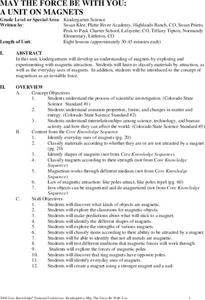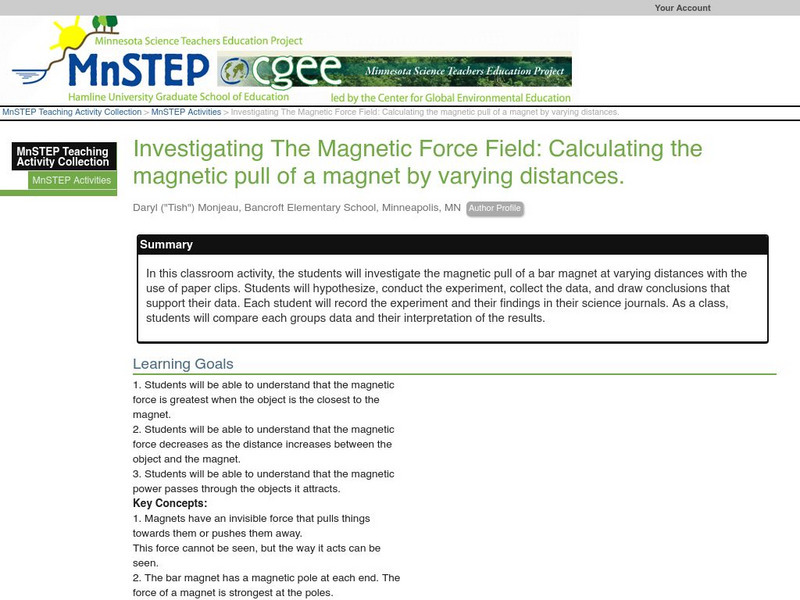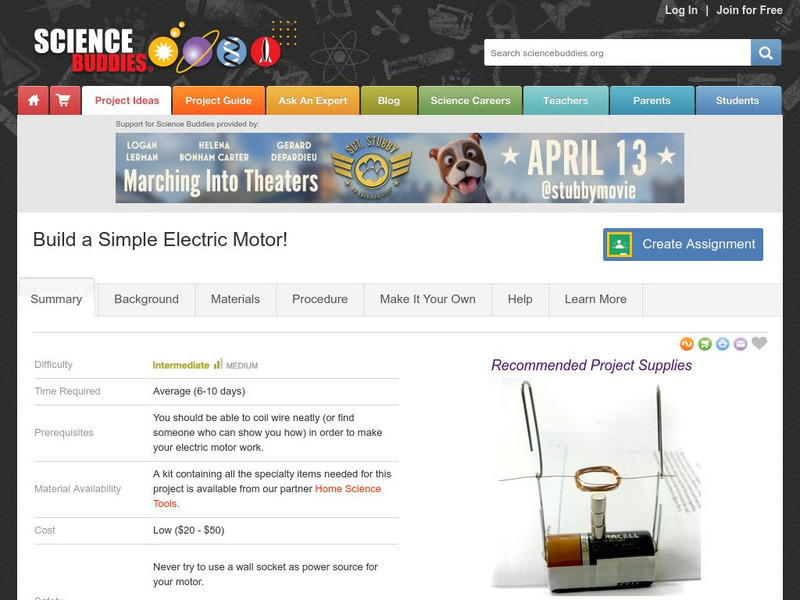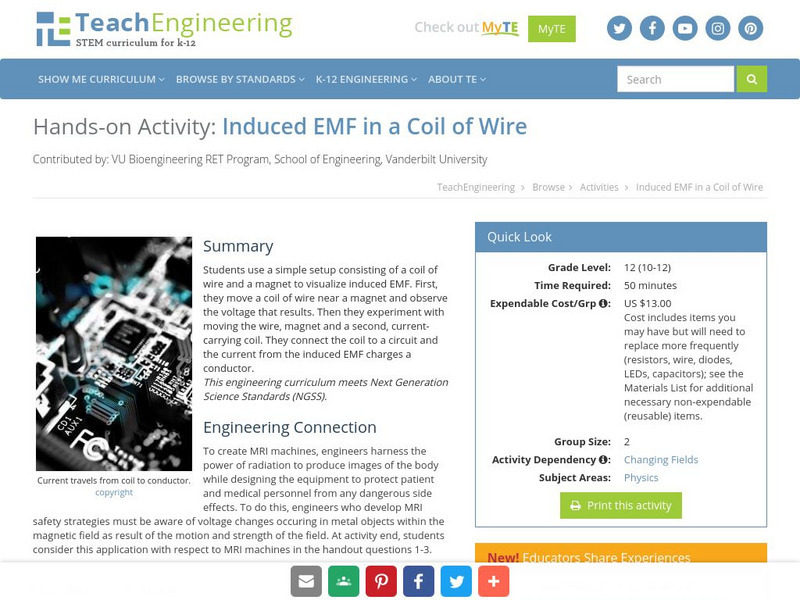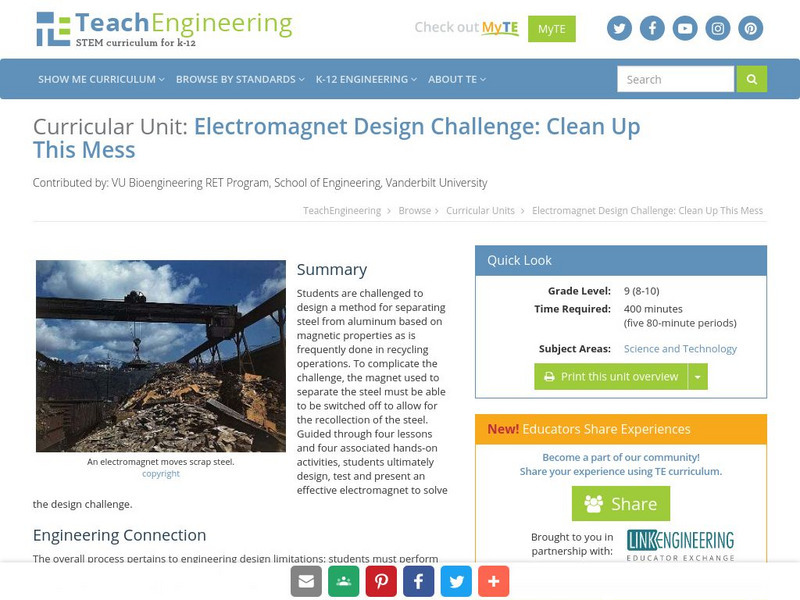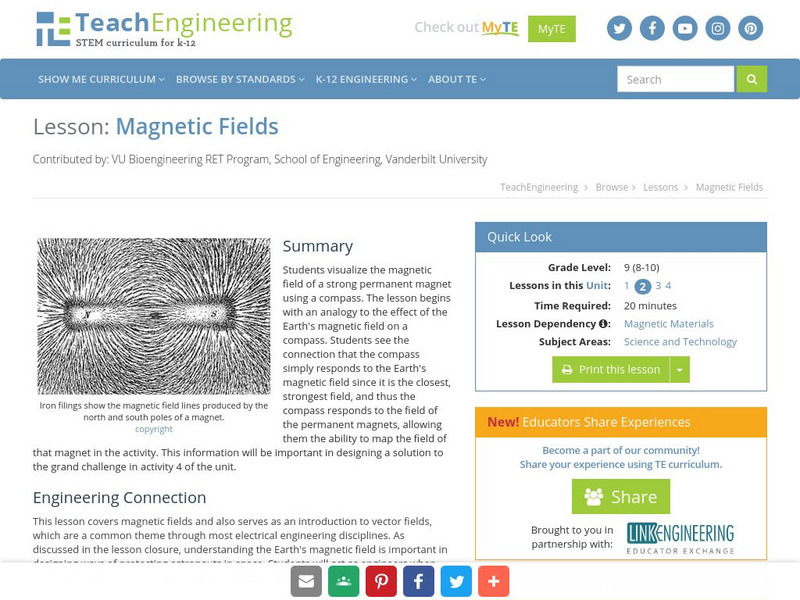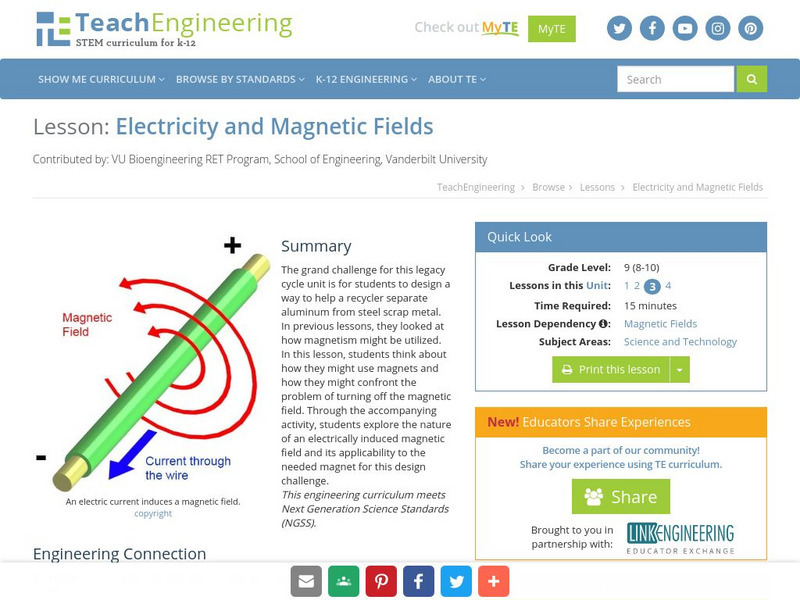Curated OER
Teaching About Magnets in Kindergarten
Students explore magnets through the five lessons of this unit. The everyday uses of magnets and an awareness of magnetic attraction form the basis of the skills presented in these lessons.
Curated OER
Magnets 2: How Strong is Your Magnet?
Students experimentally measure the strength of a magnet and graph how the strength changes as the distance from the magnet increases, and as the barrier (masking tape) is built between the magnet and an iron object.
Curated OER
What is an Electromagnet?
Students give examples of electromagnet applications. In this physics lesson plan, students explore what makes electromagnets work. They experiment picking paper clips with it.
Curated OER
About Magnets
Second graders conduct simple experiments , observe and explain what they discovered. In this simple experiments lesson students design a magnet and make a compass.
Curated OER
A Magnetic Personality
Students learn about magnets and how they are formed and used. In this magnet lesson, students investigate the properties of magnets and how engineers use magnets in technology. They specifically learn about memory storage.
Curated OER
Electromagnet
In this electromagnet worksheet, students will complete a graphic organizer by writing in the definition and 6 uses of electromagnetism.
Curated OER
Amazing Magnets Crossword Puzzle
In this physics worksheet, students identify and write the correct word for each description related to magnets. There are 12 descriptions to complete.
Curated OER
May the Force Be With You: A Unit on Magnets
Students uncover data about magnets and practice classifying them by amounts of attraction and magnetism as an invisible force is introduced. The unit presents the topic within eight lessons.
Curated OER
Magnetic Art
Students explore the different fields of force of magnets and magnetized objects through the movement of metal filings. They create a work of art.
Science Buddies
Science Buddies: How the Strength of a Magnet Varies With Temperature
Physicists sometimes study matter under extreme conditions. For example, think of the emptiness of interstellar space vs. the unimaginable crush of pressure at the center of a neutron star, or an object dipped in liquid nitrogen vs. the...
Science Education Resource Center at Carleton College
Serc: Investigating the Magnetic Force Field: Calculating Magnetic Pull
In this classroom activity, the learners will investigate the magnetic pull of a bar magnet at varying distances with the use of paper clips. Students will hypothesize, conduct the experiment, collect the data, and draw conclusions that...
Society for Science and the Public
Science News for Students: 3 D Printers Offer Better Way to Make Some Magnets
Oak Ridge National Laboratory in Tennessee has been working on a way to cut back expenses on powerful magnets used in various objects we use every day like computers and cars. Science News for Students probes into the investigation's...
Science Buddies
Science Buddies: Spin Right 'Round With This Simple Electric Motor
If you put on clothes that were washed in a washing machine, rode in a car, ate food from a fridge, warmed up lunch in a microwave, or played a video game, you used an electric motor. Try this science fair project and you'll learn how to...
Canada Science and Technology Museum
Canada Science and Technology Museum: Background Information for Electricity
The Canada Science and Technology Museum answers some of the most common questions about electricity. For example, get the definition of electricity, the difference between alternating and direct currents, and learn how a fuse works.
Georgia Department of Education
Ga Virtual Learning: Magnetism
In this interactive unit students will see how magnets work and how they are used in some of the most useful and common devices today.
TeachEngineering
Teach Engineering: Magnetic or Not?
Students explore the basic magnetic properties of different substances, particularly aluminum and steel. There is a common misconception that magnets attract all metals, largely due to the ubiquity of steel in metal products. The...
TeachEngineering
Teach Engineering: Circuits and Magnetic Fields
In this activity, students use the same method as in the activity from lesson 2 to explore the magnetism due to electric current instead of a permanent magnet. Students use a compass and circuit to trace the magnetic field lines induced...
TeachEngineering
Teach Engineering: Visualizing Magnetic Field Lines
In this activity, students take the age old concept of etch-a-sketch a step further. Using iron filings, students begin visualizing magnetic field lines. To do so, students use a compass to read the direction of the magnet's magnetic...
TeachEngineering
Teach Engineering: Induced Emf in a Coil of Wire
Students use a simple set up consisting of a coil of wire and a magnet to visualize induced EMF. First, students move a coil of wire near a magnet and observe the voltage that results. They then experiment with moving the wire, magnet,...
TeachEngineering
Teach Engineering: Clean Up This Mess
Students are challenged to design a method for separating steel from aluminum based on magnetic properties as is frequently done in recycling operations. To complicate the challenge, the magnet used to separate the steel must be able to...
TeachEngineering
Teach Engineering: The Electric and Magnetic Personalities of Mr. Maxwell
Students are briefly introduced to Maxwell's equations and their significance to phenomena associated with electricity and magnetism. Basic concepts such as current, electricity and field lines are covered and reinforced. Through...
TeachEngineering
Teach Engineering: Magnetic Materials
Students begin working on the grand challenge of the unit by thinking about the nature of metals and quick, cost-effective means of separating different metals, especially steel. They arrive at the idea, with the help of input from...
TeachEngineering
Teach Engineering: Magnetic Fields
Students visualize the magnetic field of a strong permanent magnet using a compass. The lesson begins with an analogy to the effect of the Earth's magnetic field on a compass. Students see the connection that the compass simply responds...
TeachEngineering
Teach Engineering: Electricity and Magnetic Fields
The grand challenge for this legacy cycle unit is for students to design a way to help a recycler separate aluminum from steel scrap metal. In previous lessons, they have looked at how magnetism might be utilized. In this instructional...









